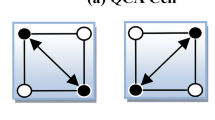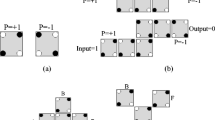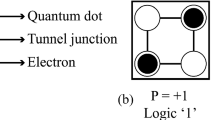Abstract
A quantum-dot cellular automaton is a new technology that solves all the disputes CMOS technology faces. Quantum-dot cellular automata-based computations run at ultra-high speeds with very high device density and low power consumption. Reversible logic design, featured in quantum-dot cellular automata, permits fully invertible computation. The arithmetic and logic units are the major components in all microprocessor-based systems that probably serve as the processing device's heart. This paper discusses an area-efficient quantum-dot cellular automata technology-based coplanar, reversible arithmetic and logic unit using the double Peres and Feynman gates. With a latency of \(2.5\) clocks and a total area of 0.1 μm2, the proposed arithmetic and logic unit performs 19 logic and arithmetic operations. QCA Designer and QD-E are used to simulate the proposed design and energy consumption, respectively. The proposed design's total energy dissipation, as measured by QCA Designer-E, is 5.45e−002 eV, and the average energy dissipation is 4.95e−003 eV. The proposed method has a considerable number of improvements in terms of latency, the number of operations, and area compared to earlier work.










Similar content being viewed by others
Explore related subjects
Discover the latest articles and news from researchers in related subjects, suggested using machine learning.Availability of data
This article contains all of the data that was created or evaluated during the research.
References
Das JC, De D (2019) Novel design of reversible priority encoder in quantum-dot cellular automata based on Toffoli gate and Feynman gate. J Supercomput 75:6882–6903
Landauer R (1961) Irreversibility and heat generation in the computing process. IBM J Res Dev 5(3):183–191
Bennett CH (1973) Logical reversibility of computation. IBM J Res Dev 17(6):525–532
Upadhyay KK, Arun V et al (2019) Design and performance analysis of reversible XOR logic gate. In: Khare A, Tiwary U, Sethi I, Singh N (eds) Recent trends in communication, computing, and electronics lecture notes in electrical engineering, vol 524. Springer, Singapore. https://doi.org/10.1007/978-981-13-2685-1-4
Snider GL, Orlov, et al (1999) Quantum-dot cellular automata. J Vac Sci Technol A Vac Surf Films 17(4):1394–1398
Heikalabad SR, Gadim MR (2018) Design of improved arithmetic logic unit in quantum-dot cellular automata. Int J Theor Phys 57(6):1733–1747
Roy R, Sarkar, et al (2021) Design and testing of a reversible ALU by quantum cells automata electron-spin technology. J Supercomput 77(12):13601–13628
Frank MP (2017) Throwing computing into reverse. IEEE Spect 54(9):32–37. https://doi.org/10.1109/MSPEC.2017.8012237
Blair E, Lent C (2018) Clock topologies for molecular quantum-dot cellular automata. J Low Power Electron Appl 8(3):1–13. https://doi.org/10.3390/jlpea8030031
Lent CS, Tougaw et al (1993) Quantum cellular automata. Nanotechnology 4(1):49–57
Bahar AN, Waheed S, Hossain N, Asaduzzaman Md (2018) A novel 3-input XOR function implementation in quantum dot-cellular automata with energy dissipation analysis. Alex Eng J 57(2):729–738
Tougaw PD, Lent CS (1994) Logical devices implemented using quantum cellular automata. J Appl Phys 75(3):1818–1825
Foroutan SA, Hossein, et al (2021) Investigating multiple defects on a new fault-tolerant three-input QCA majority gate. J Supercomput 77(8):8305–8325
Walus K, Jullien GA (2006) Design tools for an emerging SoC technology: quantum-dot cellular automata. Proc IEEE 94(6):1225–1244
Morrison M, Ranganathan N (2014) Synthesis of dual-rail adiabatic logic for low power security applications. IEEE Trans Comput Aided Des Integr Circuits Syst 33(7):975–988
Sasamal TN, Singh AK, Ghanekar U (2018) Toward efficient design of reversible logic gates in quantum-dot cellular automata with power dissipation analysis. Int J Theor Phys 57:1167–1185. https://doi.org/10.1007/s10773-017-3647-5
Hung WNN, Song X, Yang et al (2006) Optimal synthesis of multiple output boolean functions using a set of quantum gates by symbolic reachability analysis. IEEE Trans Comput Aided Des Integr Circuits Syst 25(9):1652–1663
Chaves JF, Silva et al (2015) Towards reversible QCA computers: reversible gates and ALU. In: IEEE 6th Latin American symposium on circuits & systems, pp 1–4. https://doi.org/10.1109/LASCAS.2015.7250458
Sasamal TN, Singh AK, Mohan A (2016) Efficient design of reversible ALU in quantum-dot cellular automata. Optik 127(15):6172–6182
Naghibzadeh A, Houshmand et al (2017) Design and simulation of a reversible ALU by using QCA cells to improve evaluation parameters. J Comput Electron 16(3):883–895
Babaie S, Sadoghifar A, Bahar AN (2018) Design of an efficient multilayer arithmetic logic unit in quantum-dot cellular automata (QCA). IEEE Trans Circuits Syst II Express Briefs 66(6):963–967
Sasamal TN, Mohan A, Singh AK (2018) Efficient design of reversible logic ALU using coplanar Springer Nature 2021 LATEX template 16 REV QCA ALU quantum-dot cellular automata. J Circuits Syst Comput 27(2):1850021. https://doi.org/10.1142/S0218126618500214
Oskouei SM, Ghaffari A (2019) Designing a new reversible ALU by QCA for reducing occupation area. J Supercomput 75(8):5118–5144
Norouzi M, Heikalabad SR, Salimzadeh F (2020) A reversible ALU using HNG and Ferdkin gates in QCA nanotechnology. Int J Circuit Theory Appl 48(8):1291–1303
Ahmadpour S-S, Mosleh M, Rasouli H (2020) The design and implementation of a robust single-layer QCA ALU using a novel fault-tolerant three-input majority gate. J Supercomput 76(12):10155–10185
Safaiezadeh B, Mahdipour et al (2021) Novel design, and simulation of reversible ALU in quantum-dot cellular automata. J Supercomput 78(1):868–882
Roy R, Sarkar S, Dhar S (2021) Design and testing of a reversible ALU by quantum cells automata electro spin technology. J Supercomput 77(12):13601–13628. https://doi.org/10.1007/s11227-021-03767-8
Bahar AN, Waheed et al (2018) A novel 3-input XOR function implementation in quantum dot-cellular automata with energy dissipation analysis. Alex Eng J 57(2):729–738
Walus K, Dysart et al (2004) QCADesigner: a rapid design and simulation tool for quantum-dot cellular automata. IEEE Trans Nanotechnol 3(1):26–31
Kaity A, Singh S (2021) Optimized area-efficient quantum-dot cellular automata-based reversible code converter circuits: design and energy performance estimation. J Supercomput 77(10):11160–11186
Patidar M, Gupta N (2020) An efficient design of edge-triggered synchronous memory element using quantum-dot cellular automata with optimized energy dissipation. J Comput Electron 19(2):529–542
Sill Torres F, Wille R, Niemann P, Drechsler R (2018) An energy-aware model for the logicsynthesis of quantum-dot cellular automata. IEEE Trans Comput Aided Des Integr Circ Syst 37(12):3031–3041
QCADesigner-E (2017) https://github.com/FSillT/QCADesigner-E
Khan A, Arya R (2021) Optimal demultiplexer unit design and energy estimation using quantum-dot cellular automata. J Supercomput 77:1714–1738
Funding
There are no funds, grants, or other sources of support for this research.
Author information
Authors and Affiliations
Contributions
Rama Krishna Reddy Venna and G. Durga Jayakumar were both involved in the study’s conception. Rama Krishna Reddy Venna was in charge of material preparation, data gathering, design, and analysis. Rama Krishna Reddy Venna wrote the first draft of the manuscript, and both writers commented on prior versions of the manuscript before signing off on the final version.
Corresponding author
Ethics declarations
Conflict of interest
The authors have declared that they have no conflicts of interest that are relevant to the content of this work.
Additional information
Publisher's Note
Springer Nature remains neutral with regard to jurisdictional claims in published maps and institutional affiliations.
Rights and permissions
Springer Nature or its licensor holds exclusive rights to this article under a publishing agreement with the author(s) or other rightsholder(s); author self-archiving of the accepted manuscript version of this article is solely governed by the terms of such publishing agreement and applicable law.
About this article
Cite this article
Venna, R.K.R., Jayakumar, G.D. Design of novel area-efficient coplanar reversible arithmetic and logic unit with an energy estimation in quantum-dot cellular automata. J Supercomput 79, 1908–1925 (2023). https://doi.org/10.1007/s11227-022-04740-9
Accepted:
Published:
Issue Date:
DOI: https://doi.org/10.1007/s11227-022-04740-9




